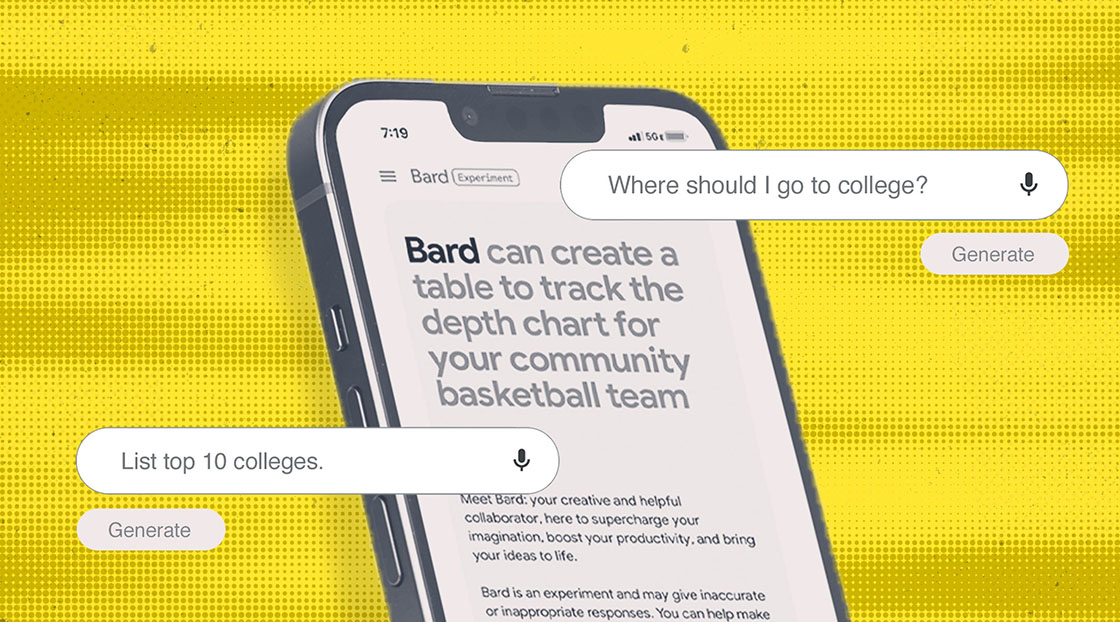I can, right at this moment, go to my Google search bar, enter a search query, and Google will, along with the search results I’m used to seeing, include results generated by a large language machine-learning model—a form of artificial intelligence. Generative AI is now officially part of how people are asking questions and getting responses.
This includes finding out what institution of higher education will be a good fit for them.
In between that last period I typed and the start of this sentence, I searched Google using the following search term/prompt: “Where should I go to college? I have good grades and want to change the world.” At first, Google responded with a list of reasons why good grades will get you into college.

But that wasn’t what I asked. It took two more prompts and an explicit request to get a list that returned what I wanted to see. Prompt engineering at work.

As a quick reference, let’s check US News and World Report’s top schools not using generative AI.

A few matching results, but not at all on the same list.
Google itself describes its generative AI search tool by saying “With generative AI in Search, we can help you understand the full picture when you’re shopping, making even the most considered and complex purchase decisions faster and much easier.”
Purchasing a higher education opportunity is a very complex decision. ‘Complexity’ is exactly the word used in “The Big Decision: The Complexity of Choosing a College,” a May 2023 story by the Thomas Worthington High School student newspaper
In higher ed marketing and communications we know—know—that prospective students are making a considered and complex purchasing decision. It’s why we do what we do every single day to recruit and retain students. Every moment of our workday goes into writing, designing, sharing, posting and engaging with content to help them make that complex choice.
But what if—no, let me change that—but what about when a machine-learning model does our work for us? It’s not us against the machines. This isn’t a piece about that. It’s us with the machines.
How can we optimize for generative AI search?
We don’t know.
We just don’t.
What we do know right now is that higher education marketers must (let’s make that a capital-M) Must start thinking about it and preparing for it. At the very least, they must start talking about it with their teams. “Google’s and Bing’s embrace of generative AI will transform search engine optimization,” Practical Ecommerce wrote in a May 29, 2023 blog post.
So here we are asking, okay, things are going to change, what can we do to start changing our carefully constructed and approved web pages to take into account the rise of generative AI search?
Here are five suggestions that in a month may seem terribly outdated, but again, we just don’t know.
First off, thanks for reading this. You could have simply asked a generative AI tool to answer this question, and it would have. But that’s the first of the five suggestions.
Write Good.
Large language machine-learning models don’t write good. Quality and clarity of writing for the web and social is crucial as we move forward with providing data for the machine-learning models to use when generating usable search results. Generative AI tools that are working to return those results are looking for high-quality pages.
A January 2023 whitepaper from Google Research describes how AI judges the quality of pages it encounters when working to return generative results. “Existing detectors of machine-generated text are effective at predicting low-quality pages, outperforming, quite surprisingly, supervised spam classifiers,” the paper reported.
Instead of an AI taking the job of your creative team, it’s making their work more essential than ever.
Keywords. Be Careful.
Machine-learning models know that keywords are a thing. They’re how the models will find content and feed the genAI interface to generate an answer for the user’s query, but make those keywords count.
Places that currently use sentence pretzels including three or four keywords or add strings of keywords to alt text and metadata of images as a way to influence current search engine optimization will now be effectively telling the model running the search that this content is meaningless for users.
According to Google’s research, “Documents that attempt to perform SEO tend to be flagged as very low quality. Since they are flagged as low quality they therefore aren’t included in the results in their generated search returns” (3.9 Qualitative Analysis).
Logical Page Structures.
If you’re a fan of Star Trek and you were to visit the thousands and thousands of pages across your web presence, would they be—as Spock would say—logical?
If not, then the machine-learning models that will be looking at your site will have difficulty identifying the important parts of the page. You also run the real risk of not being included in genAI search results. That is to say, does each page have a clear hierarchy of information (i.e., heading, subtitle, section titles and informative text) that will be quickly and easily understood by a machine?
Generative AI searches are designed to return a personalized response. If I searched “best school for computer science” and your page says “we are the best school for computer science,” an AI would see the exact answer the user asked. Your page is now more aligned with what could be considered optimized for generative AI search.
Offering specific statements on the web as a way to anticipate direct questions may be one of the most difficult parts of your team’s work. For example, when a user asks “I want the best,” you should have “We are the best.”
As higher ed institutions, we tend to shy away from bold claims like that. We prefer words such as “top school for…” or “among the leaders in…” instead. Being bolder in statements could help those who may be interested in the academic programs you offer find you versus those who are “among” the throng.
Images and Videos.
Let’s talk about undergraduate research. You’ve got great programs that put 18-year-olds into the lab to analyze samples from Antarctic ice cores. Show those images.
As ArsTechnica reported in March 2023, computer science teams are making fast advances in “allowing AI models to perceive any form of media and act on it. The machine-learning models can ‘see’ your photos, ‘watch’ your videos and ‘listen’ to your podcasts. This all feeds into the data used to answer a question like “where can I go to college to get hands-on research experience.”
Currently, search engine optimization relies on the captions and transcripts that are included on websites. Which, again, could be written specifically for SEO and, as a result, lower the AI-analyzed quality of your pages. As far as machine-learning models go, it’s still better to show than tell.
Share, Share, Share.
Attach your name to the content you want the machine-learning model to see. Social media and social network posts provide more and more chances for the models to find answers to questions.
A prospective student may ask “which school has great eSports.” Posts to your Twitch channel, clips turned into Reels, eSports athletes profiled on LinkedIn and YouTube videos from past streams, all provide those hungry machine-learning models with lots and lots of data to shape into an answer that could bring a student to apply to your school who cares nothing about where you are, the accomplishments of your alumni, your world-class faculty or even the cost of an education at your institution. They have a specific goal. Tuition and fees paid by a gamer add as much to your bottom line as a student interested in high finance. They may even be the same person.
These five suggestions—good writing, judicious keywords, logical structure, multimedia content and social sharing—are not new ideas. We do them now. The change is who the audience is.
This is a huge shift and will take some adjustment. Read it here first.
Your primary audience is now machine-learning models. Everything should be tailored to reach them.
All of the above could be dismissed as hooey in the coming months. Along with all of the hyperbole about the end of days brought about by the rise of generative AI for text, image creation and search.
Or maybe not.
We just don’t know how the world will change.
It’s not just the users that will be confronted with this changing world of online marketing; it’s also those of us who work as higher ed marketers. From Forbes:
With generative systems eating search and providing a more personalized and intimate experience for the users to connect with the products they need, the role of marketers in general may be deprioritized. Instead of pushing the products that consumers do not need it may be a good time to re-think your role in the world and consider creating or contributing to the creation of products and services that will positively impact human lives and the environment.
Well, that’s just rude!
But, not untrue.







